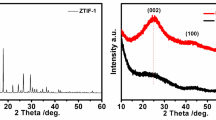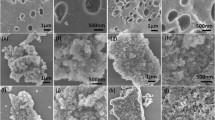Abstract
Biomass-based protic ionic liquids (BILs), green solvents with inherent properties, have the potential as precursors of functionalized catalytic carbon materials. Simple one-step design and preparation of BILs-based porous carbon-based materials remains a challenge. Our demonstration here was to use BIL as an important precursor for synthesizing porous carbon-coated CoP nanocrystals by facile one-pot carbonization process. The as-prepared CoP@NPC-900 has a specific surface area of 979.67 m2 g−1 without activator and simultaneously exhibits excellent hydrogen evolution reaction (HER) performance with a low overpotential of 181 mV at 10 mA cm−2 and small Tafel slope of 59 mV dec−1 in acid solution. In addition, density functional theory (DFT) calculations indicate lower adsorption free energy and rapid electron transfer between CoP nanocrystals and N, P co-doped porous carbon (NPC) are key factors of improving the HER performance. Our research opens up a new use of BILs, as well as provides a facile strategy to promote practical application of transition metal phosphides for HER.
Graphical abstract






Similar content being viewed by others
References
Jiao Y, Zheng Y, Jaroniec M, Qiao SZ (2015) Design of electrocatalysts for oxygen- and hydrogen-involving energy conversion reactions. Chem Soc Rev 44:2060–2086
Wang XY, Gan X, Hu T et al (2017) Noble-metal-free hybrid membranes for highly efficient hydrogen evolution. Adv Mater 29:1603617
Yang FL, Chen YT, Cheng GZ, Chen SL, Luo W (2017) Ultrathin nitrogen-doped carbon coated with CoP for efficient hydrogen evolution. ACS Catal 7:3824–3831
Ge ZH, Fu B, Zhao JP, Li X, Ma B, Chen YT (2020) A review of the electrocatalysts on hydrogen evolution reaction with an emphasis on Fe, Co and Ni-based phosphides. J Mater Sci 55:14081–14104. https://doi.org/10.1007/s10853-020-05010-w
Wan L, Zhang JF, Chen YQ, Zhong C, Hu WB, Deng YD (2020) Varied hydrogen evolution reaction properties of nickel phosphide nanoparticles with different compositions in acidic and alkaline conditions. J Mater Sci 52:804–814. https://doi.org/10.1007/s10853-016-0377-7
Ye R, del Angel-Vicente P, Liu Y et al (2016) High-performance hydrogen evolution from MoS2(1–x)P(x) solid solution. Adv Mater 28:1427–1432
Yu F, Li SZ, Chen WR, Wu T, Peng C (2019) Biomass-derived materials for electrochemical energy storage and conversion: overview and perspectives. Energ Environ Mater 2:55–67
Huang BB, Liu YC, Xie ZL (2017) Biomass derived 2D carbons via a hydrothermal carbonization method as efficient bifunctional ORR/HER electrocatalysts. J Mater Chem A 5:23481–23488
Huang BB, Liu YC, Xie ZL (2021) Two dimensional nanocarbons from biomass and biological molecules: synthetic strategies and energy related applications. J Energy Chem 54:795
Wang MQ, Ye C, Liu H, Xu MW, Bao SJ (2018) Nanosized metal phosphides embedded in nitrogen-doped porous carbon nanofibers for enhanced hydrogen evolution at all pH values. Angew Chem Int Ed 57:1963–1967
Huang BB, Liu YC, Xia M, Qiu JG, Xie ZL (2020) Building microsphere–nanosheet structures in N-doped carbon to improve its performance in the oxygen reduction reaction and vanadium redox flow batteries. Sustain Energ Fuels 4:559–570
Gao Y, Xiao ZC, Kong DB, Iqbal R, Yang QH, Zhi LJ (2019) N, P co-doped hollow carbon nanofiber membranes with superior mass transfer property for trifunctional metal-free electrocatalysis. Nano Energy 64:103879
Liu YC, Guan X, Huang BB, Wei QH, Xie ZL (2019) One-step synthesis of N, P-codoped carbon nanosheets encapsulated CoP particles for highly efficient oxygen evolution reaction. Front Chem 7:805
Fechler N, Fellinger TP, Antonietti M (2013) “Salt templating”: a simple and sustainable pathway toward highly porous functional carbons from ionic liquids. Adv Mater 25:75–79
Yang Q, Zhang Z, Sun XG, Hu YS, Xing H, Dai S (2018) Ionic liquids and derived materials for lithium and sodium batteries. Chem Soc Rev 47:2020–2064
Greaves TL, Kennedy DF, Mudie ST, Drummond CJ (2010) Diversity observed in the nanostructure of protic ionic liquids. J Phys Chem B 114:10022–10031
Zhang S, Miran MS, Ikoma A, Dokko K, Watanabe M (2014) Protic ionic liquids and salts as versatile carbon precursors. J Am Chem Soc 136:1690–1693
Miao L, Duan H, Liu MX et al (2017) Poly(ionic liquid)-derived, N, S-codoped ultramicroporous carbon nanoparticles for supercapacitors. Chem Eng J 317:651–659
Sun L, Yao Y, Zhou YM et al (2018) Solvent-free synthesis of N/S-codoped hierarchically porous carbon materials from protic ionic liquids for temperature-resistant, flexible supercapacitors. ACS Sustain Chem Eng 6:13494–13503
Sun L, Zhou H, Li L et al (2017) Double soft-template synthesis of nitrogen/sulfur-codoped hierarchically porous carbon materials derived from protic ionic liquid for supercapacitor. ACS Appl Mater Inter 9:26088–26095
Billeci F, D’Anna F, Feroci M et al (2020) When functionalization becomes useful: ionic liquids with a “sweet” appended moiety demonstrate drastically reduced toxicological effects. ACS Sustain Chem Eng 8:926–938
Costa A, Forte A, Zalewska K, Tiago G, Petrovski Z, Branco LC (2014) Novel biocompatible ionic liquids based on gluconate anion. Green Chem Lett Rev 8:8–12
Cheng J, Xu QQ, Lu JT et al (2019) Synthesis of ultrahigh surface area of nitrogen-doped porous carbon materials from alginic-based protic polyanion ionic liquids for high-performance supercapacitors. Energy Technol 7:1800734
Hao SJ, Ouyang B, Li CJ et al (2019) Hollow mesoporous Co(PO3)2@carbon polyhedra as high performance anode materials for lithium ion batteries. J Phys Chem C 123:8599–8606
Liu Q, Tian JQ, Cui W, Jiang P, Cheng NY, Asiri AM, Sun XP (2014) Carbon nanotubes decorated with CoP nanocrystals: a highly active non-noble-metal nanohybrid electrocatalyst for hydrogen evolution. Angew Chem Int Ed 53:6710–6714
Shang SL, Wang Y, Mei ZG, Hui XD, Liu ZK (2012) Lattice dynamics, thermodynamics, and bonding strength of lithium-ion battery materials LiMPO4(M = Mn, Fe Co, and Ni): a comparative first-principles study. J Mater Chem 22:1142–1149
Qian GF, Yu GT, Lu JJ et al (2020) Ultra-thin N-doped-graphene encapsulated Ni nanoparticles coupled with MoO2 nanosheets for highly efficient water splitting at large current density. J Mater Chem A 8:14545–14554
Qian GF, Chen JL, Yu TQ, Luo L, Yin SB (2021) N-doped graphene-decorated NiCo alloy coupled with mesoporous NiCoMoO nano-sheet heterojunction for enhanced water electrolysis activity at high current density [J]. Nano-Micro Lett 13:77
Yan DF, Dou S, Tao L, Liu ZJ, Liu ZG, Huo J, Wang SY (2016) Electropolymerized supermolecule derived N, P co-doped carbon nanofiber networks as a highly efficient metal-free electrocatalyst for the hydrogen evolution reaction. J Mater Chem A 4:13726–13730
Lin Y, Pan Y, Zhang J (2017) CoP nanorods decorated biomass derived N, P co-doped carbon flakes as an efficient hybrid catalyst for electrochemical hydrogen evolution. Electrochim Acta 232:561–569
Wang C, Li ZF, Wang LK, Niu XL, Wang SW (2019) Facile synthesis of 3D Fe/N codoped mesoporous graphene as efficient bifunctional oxygen electrocatalysts for rechargeable Zn–Air batteries. ACS Sustain Chem Eng 7:13873–13885
Wang J, Gao DF, Wang GX, Miao S, Wu HH, Li JY, Bao XH (2014) Cobalt nanoparticles encapsulated in nitrogen-doped carbon as a bifunctional catalyst for water electrolysis. J Mater Chem A 2:20067–20074
Hao YC, Xu YQ, Liu W, Sun XM (2018) Co/CoP embedded in a hairy nitrogen-doped carbon polyhedron as an advanced tri-functional electrocatalyst. Mater Horiz 5:108–115
Yang SS, Chen LL, Wei W, Lv XM, Xie JM (2019) CoP nanoparticles encapsulated in three-dimensional N-doped porous carbon for efficient hydrogen evolution reaction in a broad pH range. Appl Surf Sci 476:749–756
Li J, Liu GY, Liu BB, Min ZY, Qian D, Jiang JB, Li JH (2018) An extremely facile route to Co2P encased in N, P-codoped carbon layers: highly efficient bifunctional electrocatalysts for ORR and OER. Int J Hydrogen Energ 43:1365–1374
Zhang B, Wang HH, Su H et al (2016) Nitrogen-doped graphene microtubes with opened inner voids: highly efficient metal-free electrocatalysts for alkaline hydrogen evolution reaction. Nano Res 9:2606–2615
Lv XC, Yin SM (2021) CoP-embedded nitrogen and phosphorus co-doped mesoporous carbon nanotube for efficient hydrogen evolution. Appl Surf Sci. 537:147834
Ramakrishnan P, Baek SH, Park Y, Kim JH (2017) Nitrogen and sulfur co-doped metal monochalcogen encapsulated honeycomb like carbon nanostructure as a high performance lithium-ion battery anode material. Carbon 115:249–260
Wang HT, Wang W, Asif M et al (2017) Cobalt ion-coordinated self-assembly synthesis of nitrogen-doped ordered mesoporous carbon nanosheets for efficiently catalyzing oxygen reduction. Nanoscale 9:15534–15541
Sun X, Tang DH, Zhang WT et al (2018) Molten salt synthesis of Co-entrapped, N-doped porous carbon from various nitrogen precursors as efficient electrocatalysts for hydrogen evolution. J Mater Sci 54:638–647. https://doi.org/10.1021/acssuschemeng.8b03528
Huang SC, Meng YY, Cao YF, He SM, Li XH, Tong SF, Wu MM (2019) N-, O- and P-doped hollow carbons: metal-free bifunctional electrocatalysts for hydrogen evolution and oxygen reduction reactions. Appl Catal B Environ 248:239–248
Chen Y, Huang SX, Ji X et al (2018) Tuning electronic structure of single layer MoS2 through defect and interface engineering. ACS Nano 12:2569–2579
Fujigaya T, Okamoto M, Nakashima N (2009) Design of an assembly of pyridine-containing polybenzimidazole, carbon nanotubes and Pt nanoparticles for a fuel cell electrocatalyst with a high electrochemically active surface area. Carbon 47:3227–3232
Lin HL, Shi ZP, He SN, Yu X, Wang SN, Gao QS, Tang Y (2016) Heteronanowires of MoC-Mo2C as efficient electrocatalysts for hydrogen evolution reaction. Chem Sci 7:3399–3405
Fan Y, Liu PF, Huang ZY, Jiang TW, Yao KL, Han R (2015) Porous hollow carbon spheres for electrode material of supercapacitors and support material of dendritic Pt electrocatalyst. J Power Sour 280:30–38
Yu TQ, Xu QL, Qian GF, Chen JL, Zhang H, Luo L, Yin SB (2020) Amorphous CoOx-decorated crystalline RuO2 nanosheets as bifunctional catalysts for boosting overall water splitting at large current density. ACS Sustain Chem Eng 8:17520–17526
Wang YM, Qian GF, Xu QL, Zhang H, Shen F, Luo L, Yin SB (2021) Industrially promising IrNi-FeNi3 hybrid nanosheets for overall water splitting catalysis at large current density. Appl Catal B Environ. 286:119881
Zhao YX, Chang C, Teng F et al (2017) Defect-engineered ultrathin δ-MnO2 nanosheet arrays as bifunctional electrodes for efficient overall water splitting. Adv Energy Mater 7:1700005
Greeley J, Nørskov JK (2007) Large-scale, density functional theory-based screening of alloys for hydrogen evolution. Surf Sci 601:1590–1598
Zhou QS, Chen Z, Zhong LX et al (2018) Solvothermally controlled synthesis of organic-inorganic hybrid nanosheets as efficient pH-universal hydrogen-evolution electrocatalysts. Chemsuschem 11:2828–2836
Ge YC, Chen JY, Chu H et al (2018) Urchin-like CoP with controlled manganese doping toward efficient hydrogen evolution reaction in both acid and alkaline solution. ACS Sustain Chem Eng 6:15162–15169
Acknowledgements
This work was supported by National Natural Science Foundation of China (21736003, 31971614), National Program for Support of Top-notch Young Professionals, Science and Technology Basic Resources Investigation Program of China (2019FY100903), the Fundamental Research Funds for the Central Universities (2019PY13), State Key Laboratory of Pulp and Paper Engineering (2020ZR01), Guangdong Natural Science Funds for Distinguished Young Scholar (2016A030306027), Guangdong Natural Science Funds (2017A030313130), Guangzhou science and technology funds (201904010078), China Postdoctoral Science Foundation Grant (2019T120725, 2019M652882).
Author information
Authors and Affiliations
Corresponding authors
Ethics declarations
Conflict of interest
The authors declare that they have no conflict of interest.
Additional information
Handling Editor: Mark Bissett.
Publisher's Note
Springer Nature remains neutral with regard to jurisdictional claims in published maps and institutional affiliations.
Supplementary Information
Below is the link to the electronic supplementary material.
Rights and permissions
About this article
Cite this article
Ma, J., Chi, X., Huang, Y. et al. Biomass-based protic ionic liquid derived N, P, co-doped porous carbon-coated CoP nanocrystals for efficient hydrogen evolution reaction. J Mater Sci 56, 18188–18199 (2021). https://doi.org/10.1007/s10853-021-06235-z
Received:
Accepted:
Published:
Issue Date:
DOI: https://doi.org/10.1007/s10853-021-06235-z




